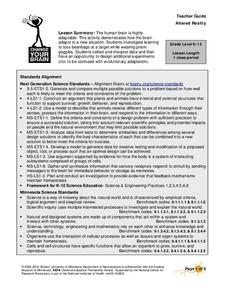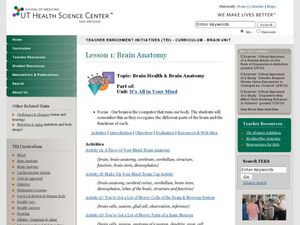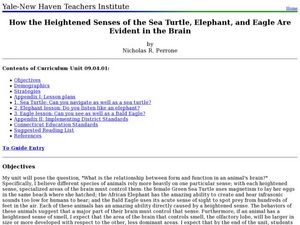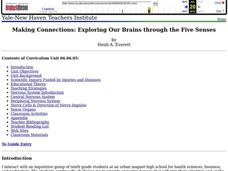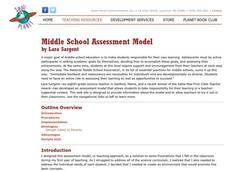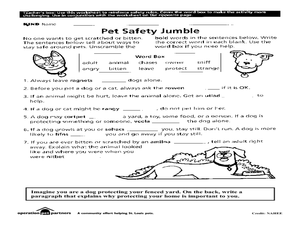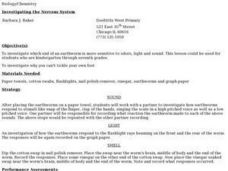University of Minnesota
Altered Reality
Fascinate young life scientists by showing them how their brain learns. By using prism goggles while attempting to toss bean bags at a target, lab partners change their outlook on the world around them, producing amusing results....
Curated OER
Brain Anatomy
Young scholars explore the brain. In this brain anatomy lesson plan, students explore the brain, identify the parts and neurons. They identify nerve pathways involved in daily activities.
Curated OER
How the Heightened Senses of the Sea Turtle, Elephant, and Eagle Are Evident in the Brain
Students explore the senses of different animals. For this biology lesson plan students will study the animals selected for their grades. The students will learn about the brain and how the senses of that animal have developed.
Curated OER
The Human Body: A Life-Size Model On Paper
Learners create a life-size paper model of the human body. They identify the major organs and state their fuction. They complete a quiz to end the lesson.
Curated OER
Making Connections: Exploring Our Brains through the Five Senses
Students identify structures of the brain, and neurons and analyze their functions. In this nervous system lesson students create drawings and models of anatomy.
Scholastic
Study Jams! The Senses: Tasting
Mmmmmmm, here is a tasty little slide show to use when introducing upper-elementary learners to the sense of taste. Photographs and detailed computer images accompany explanatory text about how the taste buds and the nose send signals to...
Curated OER
Nervous System
Get to know the body's central nervous system through an engaging game of nervous system telephone. But this isn't your average game of telephone. Here, pupils must find a way to communicate a message to the brain without speaking....
Curated OER
Disorders of the Brain
Students, in groups, conduct research about a specific disorder of the brain, create a character study of a person with that brain disorder, and then present the information to the rest of the class.
Curated OER
How We Learn About the Brain: Teaching the Infant Brain
Students describe the development of an infant from conception to birth. In this biology lesson, students discover how a child's brain develop. They explain how children acquire motor and cognitive skills.
Curated OER
Coping with Changes
Middle schoolers build on knowledge of brain and nervous system in order to write about how their nervous systems help them cope with change in environment. Students navigate online sites to explore different parts of brain and nervous...
Curated OER
The Real Deal on the Digestive System
Sixth graders explore the human body by viewing video clips. In this digestive system lesson plan, 6th graders discuss what they think happens when they swallow food. Students view a Brain Pop clip demonstrating the digestion of food and...
Curated OER
Stem Cells: 5 Year Progress Report
Students explore different aspects of stem cells. In this human biology lesson plan, students complete numerous activities including reading an article and discussing it, watching a video on stem cells reproducing over time, and...
Curated OER
Making Connections: Exploring Our Brains through the Five Senses
Young scholars record observations and create drawings and models of anatomy using their five senses. They describe the structures of a neuron and analyze each of their functions. They compare and contrast the typical structural...
Curated OER
The Digestive System
Discover how the human body's digestive system works with a brain and stomach friendly activity. Scholars taste test a variety of foods to find out how they behave once in the mouth. Class members then play a game called Move That...
Curated OER
Sense of Hearing
Create a graphic organizer to review parts and systems of the body, then present a new topic. Special education students grades 3-5 learn about the sense of hearing. They draw parts of the ear, sign a song, read Perk Up Your Ears, and...
Curated OER
How Alzheimer's Affects the Brain
Pupils study how Alzheimer's affects different parts of the brain, sketch a healthy neuron and its parts, and diagram brain changes during the early and late stages of Alzheimer's.
Curated OER
The Nervous System
Students investigate the nervous system. In this anatomy activity, students identify and define vocabulary related to the nervous system. Students role play the parts of a nervous system and perform an experiment measuring and comparing...
Green Education Foundation
How Loud is Too Loud?
Ever wonder how loud a sound has to be to cause damage? Young scientists explore sound properties by researching decibel levels. They discuss how sound is perceived by our ears and our brains and why it can cause negative health effects...
Curated OER
The Human Organism
Eighth graders investigate animal behavior by studying the lives of three female behavior scientists. In this human organism lesson students do different activities that inquire and approach each females work.
Small Planet Communications
The Nervous System
Eighth graders perform a variety of activities to explore the human nervous system--making posters, charts, presentations, etc. All activities are extremely well designed and planned for clear assessment.
Curated OER
Weathering Agent 007
Students are introduced to the concept of weathering. In groups, they use the internet to research the various types of weathering agents and their effect on different materials. Using photographs, they discuss the role humans play in...
Curated OER
Are You an Animal Safety Sleuth
In this animal safety lesson, students brain-storm ways to be kind and safe with animals throughout the year. Students create a Kind Calendar for Animals in art class and distribute copies to other classes in the school. grocery stores,...
Curated OER
Blood Vessels & Circulation
Learners participate in a layered curriculum designed instructional activity in order to study the cardiovascular system of the human body. The assessments and activities are student centered.
Curated OER
Earthworm Nervous System
Investigate the nervous system of an earthworm! Your class gets into pairs to test, record, and draw conclusions about the reaction earthworms have to different stimuli (sound, light, and smell).


